I must confess it was something of a relief to be leaving England on Boxing Day, 2013. Much of the countryside had been inundated by the incessant rain of the week leading up to Christmas. Although the temperatures had been mild for the most part, the rain literally put a dampener on most activities. It was living up to its colloquial name marvellously well: mud island. I jetted out of Gatwick Airport at a modest 0930 hrs (we had been delayed an hour by the shear amount of baggage the Algerian-dominated passenger contingent was trying to take aboard) and I took this shot with my phone – in flight mode of course – looking west along the southern coast of the UK just to the east of the port city of Southampton.

During the flight we made up for lost time with a strong tailwind blowing us across France, up and over the Pyrenees and Spain, then Barcelona and a blue and beautiful Mediterranean and finally Algiers. On the approach I could see it was a blustery day, the waves cresting and foaming energetically. The sun shone on the city and I got a good shot of our shadow cast upon a field as the aircraft dipped in towards Algiers International. I disembarked from the aircraft into a cooler-than-expected Algiers. As expected there was a fairly strong breeze gusting along the airport tarmac. I took my position in the bus that would ferry us to the terminal and soon found myself in the queue at the immigration desk. I was admitted without a hitch and continues on towards the baggage collection area.
At the carousel my fellow passengers gradually collected their bags and departed whilst I remained standing forlornly as the last of them was tossed out of the hatch. I caught the eye of one of the airport staff and explained my predicament to him as the remaining few continued doing an endless circuit, evidently in the absence of their owners. He did his best to try to assuage my anxiety. After hearing me describe it as a black bag with wheels and straps (for doubling as a backpack) he proceeded to grab the several remaining bags on the carousel (mainly black with wheels as it happened), each time asking optimistically if this might just be my lost bag? I tried my best to put on a stoic face but I had that feeling in the pit of my stomach that I wasn’t going to see my bag again that day, nor for a while yet. I thanked my friendly assistant with what grace I could muster and made my across to the Swissport desk who dealt with lost baggage enquiries. The first thing the assistant there asked me for was my boarding pass which I had printed off at home before I departed.
“Mr Schiller?” he enquired of me. Looking puzzled he showed me the baggage tag which the British Airways attendant at the baggage drop at Gatwick had stuck to my paper boarding pass. It read Schiller, R57LWZ, Cancun. “That’s just great” I though to myself. In all probability my bag was en route to Mexico in my name. There was nothing for it though, so leaving my name and my friend’s Algerian mobile number I proceeded through to the arrivals hall. Fortunately I had all essential items in my hand luggage: passport and money chief amongst them. I also had a couple of shirts, my camera, a spare mobile phone (which proved better able to roam than my smart phone) and some other trinkets. I would be ok. In some ways it would prove a blessing actually. We would be moving around a lot and one bag was ideal.
Sofian met me with a big smile and no recriminations even though he had been there since the morning. We strolled outside into a breezy Algiers and a car park populated by a surprisingly cosmopolitan array of vehicles, mostly modern Peugeots, VWs and Citreons. Whilst in Algeria I saw representatives of almost all popular Western brands, luxury models aside. I would also see many, many relic Peugeots which put me in mind of Zimbabwe where I spent my childhood. A particularly popular and resilient model is the one pictured below taken in another part of the country.
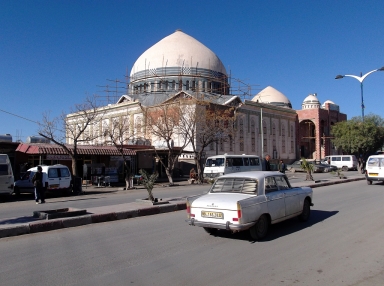
I knew Sofian from Turkey where we had taught together during the summer. We had taught English to children at a language school in a provincial town in the north of the country and had a thoroughly good time of it. We had shared a large living room in the apartment of one of the resident male teachers and we had become friends. I had never had a close Muslim friend before and observing the young man in the practise of his faith and the daily ritual of prayer was an eye opener for me. We managed to co-habit without issue and I found him good-humoured and as curious about me and my culture as I was of his. He had extended the invitation for me to visit Algeria several times before I had taken him up seriously a few weeks before Christmas. We had to act speedily to get the visa application in, Algerian visas being allegedly quite tricky to obtain. I had no trouble though and was granted 90 days with his letter of invitation.
Our first stop was the Hotel Khadidja in central Algiers. We took a taxi to the vicinity of the Grande Poste d’Alger where we disembarked. We proceeded to walk down the Rue Larbi Ben M’hidi, a road I would tread many times whilst in Algiers both then and later. I was immediately struck by the wealth of colonial architecture in the city. I imagine that Algiers had been an amazingly beautiful place in its heyday, and I say that at the risk of sounding like a colonial apologist. However I am not. Having talked to a number of Algerians, young and old, I am left in no doubt that the French, like so many imperial powers, suppressed the native Algerians in an effort to keep hold of the reins of power for as long as possible. All the same, from a purely aesthetic perspective one can hardly fail to admire the magnificent buildings adorned by balconies with stylised ironwork, louvred windows, plaster figurines and ornate sculptured reliefs. When I ventured to discuss the legacy with Sofian he just smiled and said, “the French built such magnificent buildings because they thought that they were never going to leave Algeria.”
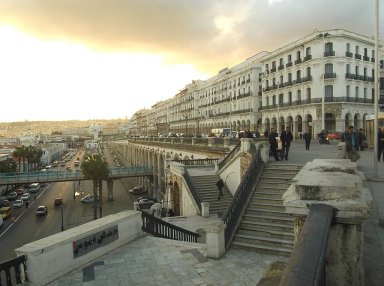
Sofian had stayed at the Hotel Lala Khadidja once before and assured me it was habitable. We obtained a room on an upper floor for the very reasonable overnight fare of 900 Dinar each (approximately $9 pp). The room was clean with the advantage of having both a basin and our own shower. The ceiling was improbably high and a tall French-style door opened onto a narrow balcony with wrought-iron railings. It was obviously largely unchanged since it was built many decades before in another era.

The ascent to our floor was by a fantastic old, spiral staircase made of marble, pictured here:

The main drawback was that the room was pervaded by a smell of unknown origin (Sofian thought it was from the shower, I imagined it emanated from some pipework near the basin). Another was that the communal toilet was enclosed in a minute closet. It was notionally of European design but there was no paper, replaced instead by a hose attached to the wall for the necessary procedure. This was not in itself a problem except that there was no where for the water to drain other than the bowl and the tiny space within was usually drenched.
The view from the balcony was charming. To my left I could see back towards Rue Larbi Ben M’hidi but the view was mostly obscured by the building opposite, also of colonial design, but like most of them in Algiers in need of a lick of paint. Directly below was a street heading in a southerly direction and between the building I just described and a newer, ramshackle block of flats was a smaller side-street heading in the direction of the Ibn Badis Mosque. I could just make out the tops of the minarets over the assortment of satellite dishes, aerials and apartment blocks. The newer buildings were of suspect build but possessed a fascinating assortment of detritus, potted plants and ones that had germinated in situ, cables, household wares, rugs and clothes lines. Sofian had lamented on the lack of conformity to any sort of standard but there was a certain charm nonetheless. He did say that an earthquake in a town near the capital ten years before had caused much damage to the newer buildings. I’m not sure of the risk posed by seismicity to the Algiers laid out before me?

That evening we walked along the Rue d’Angkor which runs parallel to Port Said. This is an absolute must for any visitor to Algiers. The view and ambience are simply magnificent, especially in the evening light. A few cargo ships sat in dock loaded high with containers near some large hoists ready to load and unload the goods. Between the road and the port was a busy dual carriageway and a railway. As one walks in a northerly direction past the various terminals one approaches a Naval base which is off-limits but the view to the south and east is well worth taking in. From there we followed the road round to the north-west watching a group of young boys playing football on a fabulously smooth, paved boulevard probably unchanged since colonial French times and still in remarkably good condition. From there we approached another square and a fountain set against a backdrop of buildings and a mosque in one direction and seaward, a number of palm trees framed against the clear, late evening sky which was fading to hues of purple and indigo.

We decided to spend a further day and Algiers in order to visit some of the notable landmarks, starting with the statue of the Emir Abdelkader which we had passed the day before en route to the hotel. He is a historic liberation figure brandishing a sabre astride his horse, standing impressively upon a large base on which is written an Arabic inscription and alongside a bass relief of the Emir and a companion presumably heading into battle. The road encircled the Emir and the view down the Rue on either side was an impressive avenue of evergreen trees. A number of buildings flanked the Place d’Emir Abdelkader: a bank, a police station, a café called the Milk Bar where we had breakfasted and a library, intriguingly called Librairie du Tiers Monde or the Library of the Third World! We investigated at a later date and found it full of modern texts mostly in French, some in Arabic but almost nothing in English, a fact Sofian commented on disparagingly.
From there we had a closer look at the magnificent Grande Post or central post office with its huge, commanding entrance archways and beautiful decorative relief within. Sofian pointed out that inscribed beneath the upper floor around the perimeter of the building are the names of all 48 wilayas or provinces of Algeria. Sofian had an account with the post office and went in to draw some money. He suggested we wait until going to his home town before changing any of my US dollars on the black market. He distrusted the money changers in the capital reckoning they wouldn’t give us a fair rate. As it was the official rate of the dinar to the dollar was about 80:1 whilst on the black market one could realise 110:1. I was familiar with such disparities from living in Zimbabwe for so many years where foreign currency shortages were acute and the exchange differential before we officially adopted the US dollar in place of our own hyperinflated one had become stupendously large.

Shortly before 12 we had returned to the hotel from where Sofian had proceeded to the nearby Ibn Badis mosque for midday prayers. I took the opportunity to return to the area around the Grande Poste whilst the majority of the populace was either within the mosques or indoors. It always astounds me how quiet the streets in a Muslim city or town go at this hour. I walked up a street flanking the public gardens above the Grande Poste adorned by trees and shrubs, road-side stalls, a fountain and a stairway ascending to a summit. At the summit was a monument that I can only describe as anomalously ugly in relation to its surrounds. It is an angular white-washed object with a pair of hands breaking free from a pair of manacles on the one side and the just-discernible face of soldier on the other. Sofian and I passed it later and he referred to it as a Socialist creation. It was obviously commemorating the liberation of Algeria from the French in 1962.
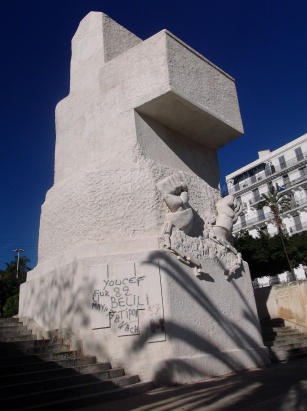
Once we had eaten we proceeded to catch a taxi to the Jardin d’Essai which we had passed on our way in fro the airport. This is a relic of the colonial era, Algier’s most significant botanical gardens. The name translates literally as the ‘garden of trials’ or ‘experimentation.’ Intriguing, I’m not sure what exactly the French engaged in here! The gardens are a surprising find and well patronised by the local populace. Sofian lamented that there wasn’t a culture of gardening or of creating gardens, public nor private, in the culture of modern Algeria, a sentiment echoed by a friend of his I spoke to later on the trip. Nevertheless that the government has maintained the public gardens here and elsewhere in the city is something to commend them on. The Jardin d’Essai are literally an oasis of green in the metropolis. They possess some imposing specimens, particularly some species of figs with huge buttresses and immense branches sprouting roots which hung down like tresses. There were also some charming statues of native Algerian figures set amongst the trees, a series of ponds with mallard ducks and geese, several buildings and greenhouses and a number of straight paths flanked by avenues of unusual trees and palms.
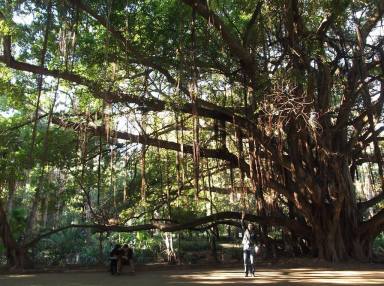
After enjoying the gardens we proceeded to a smaller Jardin Zoologique i.e. a Zoo, near the eastern entrance. We had to kill a bit of time waiting for the gates to open at 11 o’clock and by the time we returned there was a large, somewhat disorderly queue of people waiting admission. It seemed to split in two so I joined one half whilst Sofian waited in the other. His queue seemed to bloat the closer it got to the admission desk whilst mine seemed a bit more orderly so he came across and we were eventually admitted after about thirty minutes or so. It was one of the many occasions where we shared a laugh over our common experience of what he called ‘Mama Africa’. He would say this with a broad grin.

Sofian had been to the gardens before with other friends from abroad, including an American friend, Robyn, who he had befriended in Turkey on a winter camp earlier in the year. She had expressed no interest in going to the zoo but I was curious to see what state the animals were being kept in. I was not entirely surprised to find it a fairly bland establishment but I’m not sure how critical I should be considering that most Algerians that visited had probably not seen much in the way of wildlife. The north of the country was far more developed and populated after all. I’m not sure that zoos anywhere can hope to emulate the natural environment of an animal in its entirety but the patrons of the Jardin Zoologique could have done better in so far as providing some more greenery for its animals. The cages housing the big cats: several lions, a pair of leopards and a pair of tigers, were almost devoid of vegetation. The latter beast paced up and down impatiently behind the bars of his enclosure. I had seen many of these animals before in other zoos in far-flung places, but I was secretly pleased to be able to observe at first hand a den of small, furry desert foxes curled up in the cool winter sunshine. Their ears were anomalously large which would help them to thermoregulate in their desert environment in the scorching summer months. There was also an enclosure with several gazelle species which inhabited the interior of the country. I wasn’t lucky enough to see any in the wild so this was also fortuitous in hindsight. I was to see numerous camels but the first I set eyes on was here at the zoo. The animal was chewing on a bar to his enclosure and a white, milky latex covered his gums and that part of the bar on which he was so intently working his discoloured teeth. I was not particularly taken with the animal I must say!
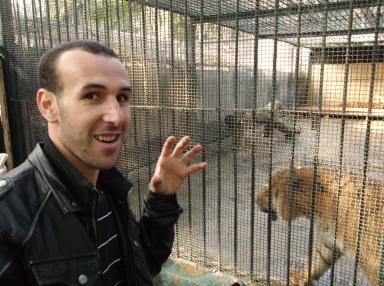
After our excursion to the zoo we walked back across the Jardin d’Essai and over the road to where a cable car ferried passengers up to the Monument du Martyre, an imposing concrete structure composed of three limbs, for want of a better word, converging on each other higher up before twisting and flaring near the top. It is the chief monument commemorating the sacrifice made by native Algerian citizens in the war of independence against France, literally translated as the Monument of the Martyr(ed). It’s shear size and pivotal location overlooking the surrounding city was obviously intended to convey the importance and solemnity of the achievement. A number of policeman positioned intermittently around the base of the monument prevented people from crossing the polished floor, whether to observe the inscription at the centre or to access the port-side perimeter of the monument. Later however, after dusk, when the crowds had dissipated we were able to gain access to the floor area but was prevented from taking too close a look at what looked like the bowl of a fountain at the very centre. On the earlier occasion we walked around the perimeter as Sofian explained to me who the statues represented and what part they had played in the struggle before being martyred.


As evening approached we had wandered across to a nearby multi-tiered shopping centre where people were enjoying entertainment of sorts including a jumping castle for kids and music. Whilst standing on one of the levels looking down upon the central square and its shrubs and fountains Sofian suddenly paused as he glimpsed someone standing nearby. It was his friend Krimo from university. A bizarre coincidence what might say but then again I discovered that Algerians were liable to travel large distances regularly. After all, at 2.3 million km2 it is now Africa’s largest country (after the separation of Sudan). I disovered that Sofian was often in touch with fellow travellers which would prove useful in the acquisition of lifts to and from various towns. Krimo was in Algiers with a group of young Cub Scouts whom we had seen amongst the throng at the monument half an hour or so earlier. They were visiting some sights outside of Algiers the following day and we were invited to join them. Sadly our schedule prevented us from doing so but not for the first time I was impressed by the friendliness of a young, educated, Algerian who spoke commendable English and who professed to look to the Anglophone world rather than the Francophone as a source of inspiration. There was a notable exception to this observation, but I will come to Ahmed later!
My introduction to Algerian cuisine was a favourable one. In the morning we had dined at the Milk Café near the statue of the Emir, drinking crème (basically a small latte) and eating French pastries: mille-feuille and croissant chief amongst them. The mille-feuille was a sort of composite creation of layered puff pastry alternating with pastry cream and topped with striped, glazed icing. It was delicious. Sofian showed me how it was traditionally eaten: one inserted a knife beneath a central layer of pastry and inverted the top half so that the glazed surface was now in the middle of the slice instead. Allegedly this prevented the icing from sticking to the roof of one’s mouth. The breakfast was the most obvious relic of French influence on the Algerian cuisine, but one that I didn’t mind one little bit! But perhaps the most significant endowment of the former colonists was the language. Everyone in Algiers seemed conversant in French and although spoken less in the smaller towns and villages we would visit later, the road and shop signs throughout displayed in French and Arabic and only rarely in English. Arabic is still the mother tongue, although numerous local dialects are spoken, and it is noteworthy that Algerian Arabic seems to have adopted a fair smattering of French words. For instance, listening to them converse in Arabic I noticed that many native Algerians often denoted numbers in French; dix, vingt, trente, cent, mille etc. My command of French was limited to GCSE Level done many years ago but I understood more than I could talk. It was nice to feel the Romance language on my tongue again but I lacked confidence and I got the feeling that not all Algerians, Sofian included, were particularly fond of the language for reasons I elaborate on elsewhere.
That evening we ate at one of the many roadside cafés in the vicinity of the hotel. I tried one of the local soups or shorba, and followed that up with a large plate of couscous. I knew that couscous was a regional staple and I expected to eat it frequently but was amused to hear from some of the young Algerians I met that they grew tired of eating it too often, besides which there proved quite a diversity of alternative main dishes. The ‘stew’ for the couscous was served in a separate bowl and one ladled it on as one saw fit. Meat was an integral part of any main meal I discovered, whether chicken, goat, mutton or beef. Often hunks of meat were served up alongside a stew to supplement the main dish.
We slept again at our hotel, having decided that there wasn’t much point moving and that the pros outweighed the cons. All the same the unpleasant odour we had noticed the day before seemed stronger that night. I read somewhere that one can expect smelly rooms in most budget accommodation in Algiers, probably a consequence of the old and decrepit plumbing. We opened the louvred doors to the balcony and let the sweet night air fill the interior. The smell receded and we got a decent night’s sleep even if we did have to throw an extra blanket on our respective beds.

The following morning we took breakfast at a pavement café near the Grande Poste and the juncture of one of the major pedestrian thoroughfares in the district. We would frequent the place several times before I returned to the UK . It was a great place to observe the ebb and flow of human traffic. Most young people in the capital dressed in Western-style clothing. The majority of the young women wore coats, close-fitting trousers and boots as I imagine girls of a similar age were wearing throughout Europe at that time of year. Many wore the muslim headscarf or hijab but a significant minority chose not to. The guys also wore coats and denims and many sported fashionable sports labels like Adidas as well as shirts and tracksuit tops belonging to big name football clubs like Barcelona and Manchester United. Some of the older generation dressed in a European style as well, particularly middle-aged women, but many older women wore shawls and hijab and occasionally a full burkha wearer would come past. The burkah is a very conservative one-piece shawl which covers a woman from head to feet with only a small slit for the eyes. It has a strict religious significance to the wearer. Beggars were present but not a persistent problem. Sofian pointed out a dark-skinned woman with young children seated against a wall with a begging bowl placed before her crossed legs. Besides her darker complexion she wore a brighter shawl and headscarf. “She’s from Mali” he explained. “You will see many of them begging. They have come here because of the conflict.” Indeed I would see them in all the other major towns we visited.
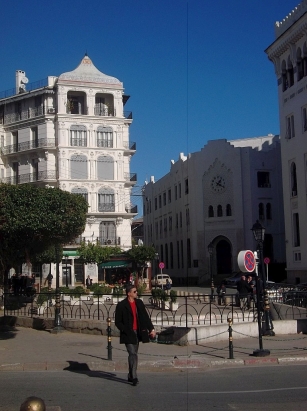
From the café we headed off to visit the Notre Dame d’Afrique, an allusion to its grander counterpart in Paris. All the same I was very surprised to see such a large European-style basilica sitting prominently on a hilltop to the north of Port Said vested with an unimpeded view out to sea and back along the coastline to the east. I picked up a brochure in the foyer of the church which describes it as being built in the Byzantine style pointing north-east towards Rome and the Vatican. The first foundation stone was laid in 1855 and it was finally completed 17 years later in 1872. Within is a bronze statue of the Virgin Mary which originated in France and which was venerated at two different locations before finally coming to reside at the Notre Dame d’Afrique. The brochure also alludes to the large number of marble tablets I witnessed adorning the interior walls which tell of the gratitude of many priests, monks and nuns for the founding of their orders throughout the continent. Whilst there a group of tourists entered with a guide who proceeded to relate, in French, the history of the church. Although I couldn’t follow him very well I was happy to lose myself in the inscriptions and abundant iconography within. To my left was the Nativity scene set out with statuettes and so forth, a ritual that would be observed throughout the Christian world at that time of year, and at least some more unusual locations as this Basilica testified to. There were various frescos adorning the apses of the church, one commemorating the life of St Augusine of Hippone (now Annaba), another the Passion of Christ and, above the Nativity, a fresco of the Last Supper.

I found the church interior a strange melange of styles, making it a bit gaudy and inconsistent in one sense, but nevertheless fascinating in its own way. The influence of Arabic art and design is quite evident in the photograph above which I took of the left apse, as manifest in the repeating patterns around the statue at centre, whether of Christ or St Augustine I’m unsure. On our way out we encountered the amicable guide who introduced himself as an Algerian of Italian residence. He spoke several languages and communicated a warm greeting in English to me. Thereafter he spoke largely in French to Sofian about one aspect or another of the Church that interested my friend. It was then that I noticed a model sailing ship, one with multiple masts and rigging, hung against the left wall. Its significance was lost on me until I read that the Basilica, particularly in its function as host to the bronze statue of St Mary, had brought multitudes of sailors to venerate her and to ‘pray to her for deliverance from the dangers of the sea.’
Outside the Basilica we strolled in the mid-morning sunshine taking photographs and admiring the seaward view. Whilst doing so we were approached by a young girl in a hijab who started communicating with Sofian. He called me over and explained that she had heard us speaking English and was curious to know who I was. He told her that I was English and she had seemed impressed. She asked me in halting English how I was and if I was enjoying my stay in Algeria. I was quite taken aback to learn that I was the first native English speaker that she had ever met. It was to prove thus on a number of subsequent occasions. She then took out a mobile phone and she and I posed for a photo against the railings with the blue Mediterranean beyond. Smiling shyly she scuttled back to where a younger sibbling was grouped together with two older women in traditional garb. They smiled and nodded in my direction. Considering that I had avoided meeting their gaze a few minutes earlier on the assumption that their conservative dress precluded any sort of acknowledgement, I felt glad that my notion had been a false one. I wish I had managed to get a picture of my own but my camera had been on the wrong setting – my fault – and Sofian had not managed to get a shot. I did, however, get a decent picture of the Basilica which I have inserted below.

After completing our tour we descended from the lofty height of the church along winding streets to the bottom where we were able to catch a taxi back to the hotel. Catching a yellow taxi in Algiers is an interesting proposition for a Westerner because you must be prepared to share your cab with other people. I’m fairly laid back so I didn’t mind but other people might find it frustrating. The reality was that transport was extremely cheap (fuel is heavily subsidised by the government) and a journey of a few miles would only cost somewhere in the region of 40 DN per person. From the hotel we walked with our belongings down to the Gare d’Alger, Algier’s main train station. The station building was interesting in the manner of such stations in major cities around the world, both within and without. The roof was adorned by an old mechanical clock – functioning – on either side of which in large block lettering was written the name of the station in both English and Arabic. We had to cross several busy lanes of traffic before descending to the station entrance. Sofian made enquiries and we were directed to a line of carriages waiting to disembark from the opposite platform. It was a bit of a squeeze getting on and before long it was impossible to move in either direction; a bit like any London train at rush hour really. I mentioned this to Sofian who raised his eyebrows. “Public transport is not quite as civilised in England as you might imagine,” I informed him with a smile.
Whilst we stood in one of the carriages the train proceeded eastwards for five or six stops before we disembarked. We headed back in the direction from which we had come in order to find the bus and taxi terminus for our journey out of Algiers to the town Sétif, not far from where Sofian lived with his mother and sister. Although I didn’t realise it at the time Sétifian taxi drivers were not allowed access to the terminus because of some disagreement with the local Algiers taxi drivers. Sofian pointed this out later but the upshot was that one had to find a taxi on the busy roadside for the journey east. We found ourselves a suitable intercity commuter and squeezed inside with five other passengers. There were two rows of passenger seats behind the driver and another seat in front. All the bags were squeezed into the small gap behind the back row of seats. Sofian had warned me about the driving in Algeria and I now had the fortune of being able to participate in the motorway slalom. Our driver accelerated quickly to a cruising speed of about 130 kph, keeping to the left of our dual-lane, east-bound carriageway i.e. the fast lane. If there was a slower vehicle impinging on this lane he simply kept on, tonking his horn if necessary, until it moved at the last moment into the right lane for us to pass. At other times he would pass on the right and accelerate into improbably small gaps between successive vehicles. It was a white-knuckle ride but Sofian was sympathetic. “This is a problem with Algeria today. People do what they like. There is no regulation from above.” When I mentioned that this style of driving would very soon land you with several points on your driving license back in the UK he nodded seriously. “That is how it should be” he said. Then, brightening up he grinned and uttered that great phrase that could explain away all this and more: “Mama Africa!”
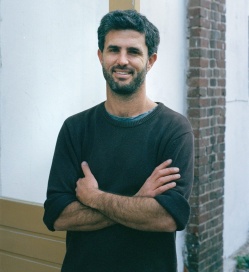

This is just terrific Leo. I loved the way you portrayed the journey to Algeria.
Concerning the mosque you took a picture of in Magra – M’sila, the benefactor is Not a rich lady with French money, it’s some wealthy businessmen in Magra who take care of building it, and as I told you, they’re doing it to reduce taxes. No wonder it took them this long to finish it, if you know what I mean.
I can’t wait to read the rest of the writing 🙂
LikeLike
Thanks mate. I really appreciate the feedback. Now I remember you telling me about the businessman! I was confusing this mosque with another that Elheer pointed out near Ain Oulmane. Apparently a young construction worker fell to his death from one of the new minarets only a few weeks back, or so he told me. Do you know the place I’m talking about? I will be sure to mention the mosque in Magra and its actual benefactor when I get to it…
LikeLike
Loved the post! You are an excellent writer! It was great to retrace some of my tour through your words.
LikeLike
Thank you Robyn.
LikeLike
Yeah, I know what you are talking about, you were mistaken because you’ve seen so many mosques lol. I’m looking forward to the rest of the writing …
LikeLike
Nice démonstration for a nice trip …. I wish it wouldn’t be the last … well it might open the way to many others .
LikeLike